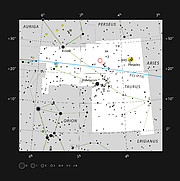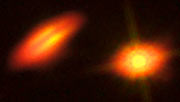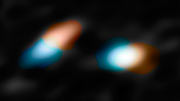Persbericht
ALMA ontdekt dubbelster met vreemde, wanordelijke planeet-vormende schijven
30 juli 2014
Astronomen die gebruik maken van de Atacama Large Millimeter/submillimeter Array (ALMA) hebben ontdekt dat de planeet-vormende gasschijven rond de jonge sterren van de dubbelster HK Tauri niet dezelfde oriëntatie hebben. De nieuwe ALMA-waarnemingen geven het duidelijkste beeld van protoplanetaire schijven in een dubbelstersysteem dat tot nu toe is verkregen. Het nieuwe resultaat helpt ook verklaren waarom zo veel exoplaneten – anders dan de planeten in ons zonnestelsel – van die vreemde, excentrische of sterk hellende banen hebben gekregen. De resultaten zullen op 31 juli 2014 in het tijdschrift Nature verschijnen.
Anders dan onze solitaire zon maken de meeste sterren deel uit van een dubbelstersysteem – twee sterren die om elkaar heen draaien. Dubbelsterren zijn heel talrijk, maar de vraag is hoe en waar in zo’n complexe omgeving planeetvorming kan optreden.
‘ALMA heeft ons nu het beste beeld tot nu toe gegeven van een dubbelstersysteem dat protoplanetaire schijven vertoont – en we hebben ontdekt dat de schijven schuin op elkaar staan!’ zegt Eric Jensen, een astronoom van Swarthmore College in Pennsylvania (VS).
De twee sterren in het HK Tauri-stelsel, dat zich op een afstand van ongeveer 450 lichtjaar in het sterrenbeeld Stier bevindt, zijn minder dan vijf miljoen jaar oud. Ze staan ongeveer 58 miljard kilometer uit elkaar – dertien keer de afstand zon-Neptunus.
De zwakkere van de twee, HK Tauri B, is omgeven door een protoplanetaire schijf die we van opzij zien en die het zicht op zijn ster ontneemt. Omdat de gloed van de ster onderdrukt wordt, kunnen astronomen gemakkelijk een goed beeld van de schijf verkrijgen door deze op zichtbare of nabij-infrarode golflengten te bekijken.
Ook de andere ster, HK Tauri A, heeft een schijf, maar deze schermt het sterlicht niet af. Hierdoor is de schijf niet waarneembaar in zichtbaar licht: zijn zwakke gloed verbleekt bij het felle licht van de ster. Maar op golflengten van ongeveer een millimeter, zoals ALMA die detecteert, straalt hij helder.
Met behulp van ALMA, hebben de astronomen de schijf rond HK Tauri A niet alleen gezien, maar voor het eerst ook zijn draaiing kunnen meten. Dit heeft hen in staat gesteld om te berekenen dat de twee schijven schuin op elkaar staan, onder een hoek van minstens zestig graden. Dat betekent dat minstens een van de schijven niet in hetzelfde vlak kan liggen als de banen van de twee sterren.
‘Deze sterk verschillende oriëntatie geeft ons een opmerkelijk beeld van een jong dubbelstersysteem,’ zegt Rachel Akeson van het NASA Exoplanet Science Institute van het California Institute of Technology in de VS. ‘Hoewel er al aanwijzingen bestonden voor het bestaan van dit soort slecht uitgelijnde stelsels, laten de nieuwe ALMA-waarnemingen van HK Tauri veel duidelijker zien wat zich werkelijk in zo’n stelsel afspeelt.’
Het ontstaan van sterren en planeten speelt zich af in enorme wolken van stof en gas. Als het materiaal in zo’n wolk zich onder invloed van de zwaartekracht samentrekt en begint te roteren, hoopt het meeste stof en gas zich op in een afgeplatte, ronddraaiende protoplanetaire schijf met een groeiende protoster in zijn centrum.
Maar bij een dubbelster zoals HK Tauri is dat proces veel ingewikkelder. Wanneer de banen van de sterren en hun protoplanetaire schijven niet ruwweg in hetzelfde vlak liggen, kunnen de eventuele planeten die ontstaan in sterk excentrische en hellende banen terechtkomen [1].
‘Onze resultaten laten zien dat de noodzakelijke voorwaarden om planeetbanen te veranderen daadwerkelijk bestaan en dat aan deze voorwaarden al is voldaan op het moment van de planeetvorming, wat blijkbaar kan worden toegeschreven aan het vormingsproces van een dubbelster,’ merkt Jensen op. ‘We kunnen andere theorieën niet uitsluiten, maar we kunnen zeker stellen dat een tweede ster dat voor elkaar krijgt.’
Omdat ALMA het anderszins onzichtbare stof en gas van protoplanetaire schijven kan zien, kon een ongekend beeld van dit jonge dubbelstersysteem worden verkregen. ‘Omdat we dit stelsel in een pril stadium waarnemen, met protoplanetaire schijven die nog intact zijn, kunnen we beter zien hoe een en ander georiënteerd is,’ legt Akeson uit.
Vooruitkijkend willen de astronomen onderzoeken hoe normaal een dubbelster als deze is. Om te kunnen vastellen of het om een bijzonder individueel geval gaat, of dat ons Melkwegstelsel wemelt van configuraties als deze, zullen meer waarnemingen moeten worden gedaan.
Jensen concludeert: ‘Hoewel dit mechanisme ons een flinke stap vooruit helpt, kan het niet alle vreemde banen van exoplaneten verklaren – er zijn gewoon niet genoeg dubbelsterbegeleiders. Dat interessante vraagstuk moeten we dus ook nog oplossen!’
Noten
[1] Als twee sterren en hun schijven zich niet allemaal in hetzelfde vlak bevinden, zal de zwaartekrachtsaantrekking van de ene ster de schijf van de andere ster (en vice versa) zodanig verstoren dat deze gaat schommelen. Ook een planeet die zich in een van deze schijven bevindt zal door de andere ster worden verstoord, waardoor zijn baan schuin komt te staan en vervormt.
Meer informatie
De Atacama Large Millimeter/submillimeter Array (ALMA), een internationale astronomische faciliteit, is een samenwerkingsverband van Europa, Noord-Amerika en Oost-Azië, met steun van de republiek Chili. ALMA wordt in Europa gefinancierd door de Europese Zuidelijke Sterrenwacht (ESO), in Noord-Amerika door de National Science Foundation (NSF) van de VS in samenwerking met de National Research Council van Canada (NRC) en de National Science Council van Taiwan (NSC), en in Oost-Azië door de National Institutes of Natural Sciences (NINS) van Japan in samenwerking met de Academia Sinica (AS) in Taiwan. De bouw en het beheer van ALMA worden namens Europa geleid door ESO, namens Noord-Amerika door het National Radio Astronomy Observatory (NRAO), dat bestuurd wordt door de Associated Universities, Inc. (AUI), en namens Oost-Azië door het National Astronomical Observatory of Japan (NAOJ). De overkoepelende leiding en het toezicht op bouw, ingebruikname en beheer van ALMA is in handen van het Joint ALMA Observatory (JAO).
De resultaten van dit onderzoek zijn te vinden in het artikel ‘Misaligned Protoplanetary Disks in a Young Binary Star System’ van Eric Jensen en Rachel Akeson, dat op 31 juli in het tijdschrift Nature verschijnt.
Het onderzoeksteam bestaat uit Eric L. N. Jensen (Dept. of Physics & Astronomy, Swarthmore College, VS) en Rachel Akeson (NASA Exoplanet Science Institute, IPAC/Caltech, Pasadena, VS).
ESO is de belangrijkste intergouvernementele astronomische organisatie in Europa en de meest productieve sterrenwacht ter wereld. Zij wordt ondersteund door vijftien landen: België, Brazilië, Denemarken, Duitsland, Finland, Frankrijk, Italië, Nederland, Oostenrijk, Portugal, Spanje, Tsjechië, het Verenigd Koninkrijk, Zweden en Zwitserland. ESO voert een ambitieus programma uit, gericht op het ontwerpen, bouwen en beheren van grote sterrenwachten die astronomen in staat stellen om belangrijke wetenschappelijke ontdekkingen te doen. Ook speelt ESO een leidende rol bij het bevorderen en organiseren van samenwerking op astronomisch gebied. ESO beheert drie waarnemingslocaties van wereldklasse in Chili: La Silla, Paranal en Chajnantor. Op Paranal staan ESO’s Very Large Telescope (VLT), de meest geavanceerde optische sterrenwacht ter wereld, en twee surveytelescopen: VISTA werkt in het infrarood en is de grootste surveytelescoop ter wereld en de VLT Survey Telescope is de grootste telescoop die uitsluitend is ontworpen om de hemel in zichtbaar licht in kaart te brengen. ESO is ook de Europese partner van de revolutionaire telescoop ALMA, het grootste astronomische project van dit moment. Daarnaast bereidt ESO momenteel de bouw voor van de 39-meter Europese Extremely Large optical/near-infrared Telescope (E-ELT), die ‘het grootste oog op de hemel’ ter wereld zal worden.
Links
• Opname van HK Tauri met de Hubble-ruimtetelescoop van NASA en ESA
• De film ‘ALMA – In Search of our Cosmic Origins’
• Meer persberichten omtrent ALMA
Contact
Eric L. N. Jensen
Lead Scientist, Swarthmore College
Philadelphia, USA
Tel: +1 610-328-8249
E-mail: ejensen1@swarthmore.edu
Rachel Akeson
NASA Exoplanet Science Institute, IPAC/Caltech
Pasadena, USA
Tel: +1 626-395-1812
E-mail: rla@ipac.caltech.edu
Charles E. Blue
Public Information Officer, National Radio Astronomy Observatory
Charlottesville, USA
Tel: + 1 434 296 0314
Mobiel: +1 202 236 6324
E-mail: cblue@nrao.edu
Richard Hook
Public Information Officer, ESO
Garching bei München, Germany
Tel: +49 89 3200 6655
Mobiel: +49 151 1537 3591
E-mail: rhook@eso.org
Marieke Baan (Perscontact Nederland)
ESO Science Outreach Network
en NOVA Informatie Centrum
Tel: +31(0)20-5257480
E-mail: eson-netherlands@eso.org
Over dit bericht
| Persberichten nr.: | eso1423nl |
| Naam: | HK Tauri |
| Type: | Milky Way : Star : Grouping : Binary Milky Way : Star : Circumstellar Material |
| Facility: | Atacama Large Millimeter/submillimeter Array |
| Science data: | 2014Natur.511..567J |
Our use of Cookies
We use cookies that are essential for accessing our websites and using our services. We also use cookies to analyse, measure and improve our websites’ performance, to enable content sharing via social media and to display media content hosted on third-party platforms.
ESO Cookies Policy
The European Organisation for Astronomical Research in the Southern Hemisphere (ESO) is the pre-eminent intergovernmental science and technology organisation in astronomy. It carries out an ambitious programme focused on the design, construction and operation of powerful ground-based observing facilities for astronomy.
This Cookies Policy is intended to provide clarity by outlining the cookies used on the ESO public websites, their functions, the options you have for controlling them, and the ways you can contact us for additional details.
What are cookies?
Cookies are small pieces of data stored on your device by websites you visit. They serve various purposes, such as remembering login credentials and preferences and enhance your browsing experience.
Categories of cookies we use
Essential cookies (always active): These cookies are strictly necessary for the proper functioning of our website. Without these cookies, the website cannot operate correctly, and certain services, such as logging in or accessing secure areas, may not be available; because they are essential for the website’s operation, they cannot be disabled.
Functional Cookies: These cookies enhance your browsing experience by enabling additional features and personalization, such as remembering your preferences and settings. While not strictly necessary for the website to function, they improve usability and convenience; these cookies are only placed if you provide your consent.
Analytics cookies: These cookies collect information about how visitors interact with our website, such as which pages are visited most often and how users navigate the site. This data helps us improve website performance, optimize content, and enhance the user experience; these cookies are only placed if you provide your consent. We use the following analytics cookies.
Matomo Cookies:
This website uses Matomo (formerly Piwik), an open source software which enables the statistical analysis of website visits. Matomo uses cookies (text files) which are saved on your computer and which allow us to analyze how you use our website. The website user information generated by the cookies will only be saved on the servers of our IT Department. We use this information to analyze www.eso.org visits and to prepare reports on website activities. These data will not be disclosed to third parties.
On behalf of ESO, Matomo will use this information for the purpose of evaluating your use of the website, compiling reports on website activity and providing other services relating to website activity and internet usage.
Matomo cookies settings:
Additional Third-party cookies on ESO websites: some of our pages display content from external providers, e.g. YouTube.
Such third-party services are outside of ESO control and may, at any time, change their terms of service, use of cookies, etc.
YouTube: Some videos on the ESO website are embedded from ESO’s official YouTube channel. We have enabled YouTube’s privacy-enhanced mode, meaning that no cookies are set unless the user actively clicks on the video to play it. Additionally, in this mode, YouTube does not store any personally identifiable cookie data for embedded video playbacks. For more details, please refer to YouTube’s embedding videos information page.
Cookies can also be classified based on the following elements.
Regarding the domain, there are:
- First-party cookies, set by the website you are currently visiting. They are stored by the same domain that you are browsing and are used to enhance your experience on that site;
- Third-party cookies, set by a domain other than the one you are currently visiting.
As for their duration, cookies can be:
- Browser-session cookies, which are deleted when the user closes the browser;
- Stored cookies, which stay on the user's device for a predetermined period of time.
How to manage cookies
Cookie settings: You can modify your cookie choices for the ESO webpages at any time by clicking on the link Cookie settings at the bottom of any page.
In your browser: If you wish to delete cookies or instruct your browser to delete or block cookies by default, please visit the help pages of your browser:
Please be aware that if you delete or decline cookies, certain functionalities of our website may be not be available and your browsing experience may be affected.
You can set most browsers to prevent any cookies being placed on your device, but you may then have to manually adjust some preferences every time you visit a site/page. And some services and functionalities may not work properly at all (e.g. profile logging-in, shop check out).
Updates to the ESO Cookies Policy
The ESO Cookies Policy may be subject to future updates, which will be made available on this page.
Additional information
For any queries related to cookies, please contact: pdprATesoDOTorg.
As ESO public webpages are managed by our Department of Communication, your questions will be dealt with the support of the said Department.







